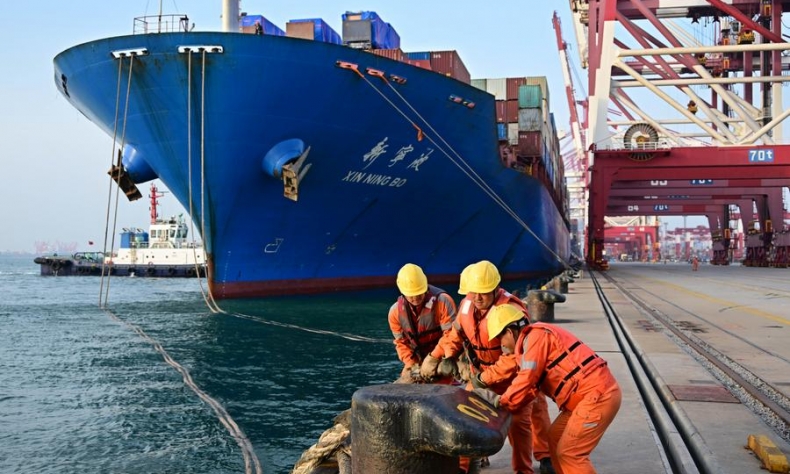Resilience by Design: How China Is Thriving Despite Tariffs

China must embrace a ‘Going Global’ strategy not only for expanding Chinese business but also for investing in shared success.
As new waves of tariffs are imposed by the United States under President Donald Trump, a familiar question has returned to the global stage: can China maintain its trade momentum under intensifying protectionist pressure? The answer, once again, is yes.
China’s total goods imports and exports rose to 21.79 trillion yuan (about 3.05 trillion U.S. dollars) in the first half of 2025, up 2.9 percent year on year. The exports rose 7.2 percent year on year during the period, while imports fell 2.7 percent. In June alone, the total value of China’s imports and exports reached 3,852.7 billion yuan—up 5.2 percent year on year—with exports rising 7.2 percent and imports increasing 2.3 percent. Even in the face of mounting external headwinds, the exports and imports continue to show resilience. This is not a fluke either. It is the outcome of strategy, structural reform, and a consistent commitment to national development.
China has been here before. The last time the United States imposed sweeping tariffs during the previous Trump administration, there were concerns that China’s heavily export-oriented manufacturing machine would be fatally wounded. But instead of retreating or escalating conflict, China adapted by diversifying trade partners. It engaged with ASEAN in Southeast Asia and became the largest trade partner of Japan, South Korea, and Australia, while also engaging in economic summits from Latin America to Africa to increase bilateral trade and competitiveness. At the same time, China accelerated innovation at home and embarked on a dual circulation strategy to boost domestic consumption and better leverage markets to the service of the common good.

The key lies in China’s ability to pair strategic foresight, openness, and its efficiencies and synergies. Firstly, China’s development is guided not by electoral cycles or short-term politics, but by a disciplined system of medium- and long-term planning. Its five-year plans, underpinned by industrial policies and infrastructure investment, create the predictability that global partners value in a volatile world. Stability, consistency, and clarity of purpose are assets and China offers all three.
Secondly, China has remained remarkably open. Rather than closing off in the face of external pressure, it has advanced economic policies that foster deeper integration with the developing world. It now offers zero-tariff treatment to nearly all goods from 53 countries in Africa. From deep economic integration with ASEAN to joining the Regional Comprehensive Economic Partnership (RCEP), China has adjusted to the new currents and possibilities underpinning our changing world.
Thirdly, China remains the world’s most complete and deeply integrated manufacturing base, not just because of scale, but because of its most complete supply chain, and its efficiency, synergy, and responsiveness. Its role in global supply chains is structural and load-bearing. With world-class comprehensive logistics, a skilled labor force, deep talent pools, and increasingly advanced automation, China can deliver and do so consistently at the right price. Even as some geopolitical forces attempt to turn away from economic globalization with calls for “reshoring” or “friendshoring,” the reality is that global businesses still rely on China, because there is no other country that offers the same combination of reliability, scale, and capability.
A major source of China’s trade strength lies in the fact that it is not just participating in the existing global economy, it is also actively building the economy of the future. The green transition is one of the defining challenges of this century, and China is already the global leader in green industry. In 2023 alone, China installed more solar power capacity than the entire rest of the world combined, at 1.6 times their total. It doubled global totals in wind turbine installations and is driving global prices for renewables to historic lows. The cost of solar fell from 24¢ per watt in 2023 to just 11¢ in 2024. Countries like Pakistan have benefited from Chinese-backed renewable projects.

It is the combination of efficiency synergy and capacity that sets China apart, especially when it comes to business. Where others hesitate, China builds. Where others promote slogans and frameworks, it delivers products. And increasingly, the world is responding. Chinese firms are forming joint ventures abroad, from Geely’s Volvo Plant in Belgium to EV production in Thailand. These are not just commercial wins; they manifest mutual benefit. Chinese investment has created jobs, infrastructure, and new technology in partner countries.
What these trade numbers demonstrate is that we are not entering a world of isolation. We are entering a world of interconnection and upgrading. If the state of global trade over the past decades has been a dance, then yes, the dance partners may change, and regional dynamics may grow more pronounced—but people are still looking for partners in the waltz. And China, by remaining open, consistent, and capable, continues to attract new partners across the globe.
The global trade landscape is thus indeed changing but not collapsing. While the U.S. share of global trade has declined to around 13 percent, the remaining 87 percent is composed of dynamic flows that are increasingly connected with China and other emerging players.
We should not be shaken by tariffs or distracted by short-term provocations. China has seen this playbook before. What matters is not simply defending the status quo, but continuing to deliver value to the global economy—especially to those countries still seeking their path to prosperity.
There is still much work to do. As China’s role in the global economy continues to grow, so too does the responsibility to ensure that growth is inclusive and constructive. Its rise continues to generate anxiety in parts of the developed world. The solution is not to slow down, but to double down on inclusive growth in both developed and developing countries. China must embrace a “Going Global” strategy not only for expanding Chinese business but also for investing in shared success.
The article reflects the author’s opinions, and not necessarily the views of China Focus.
 Facebook
Facebook
 Twitter
Twitter
 Linkedin
Linkedin
 Google +
Google +



